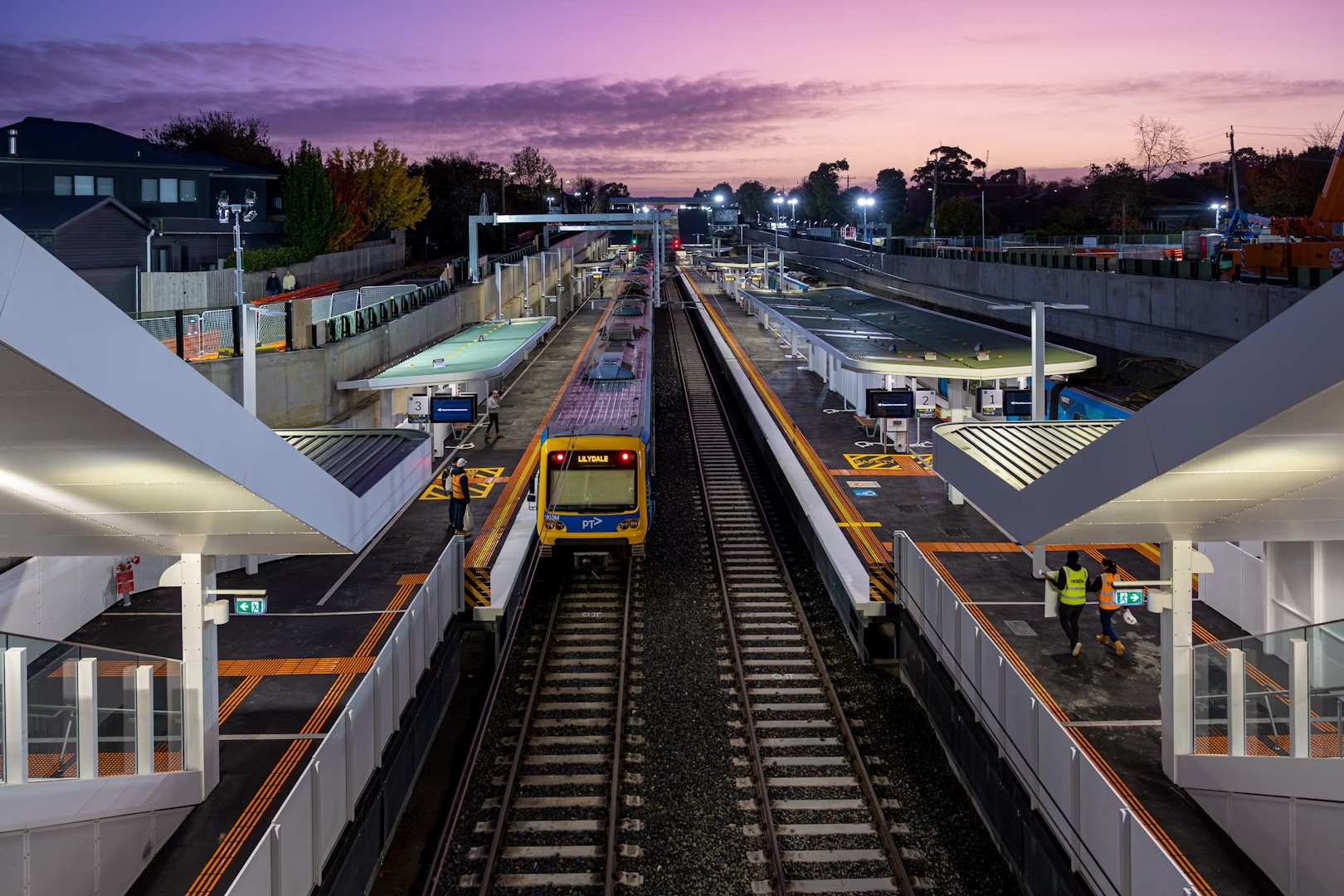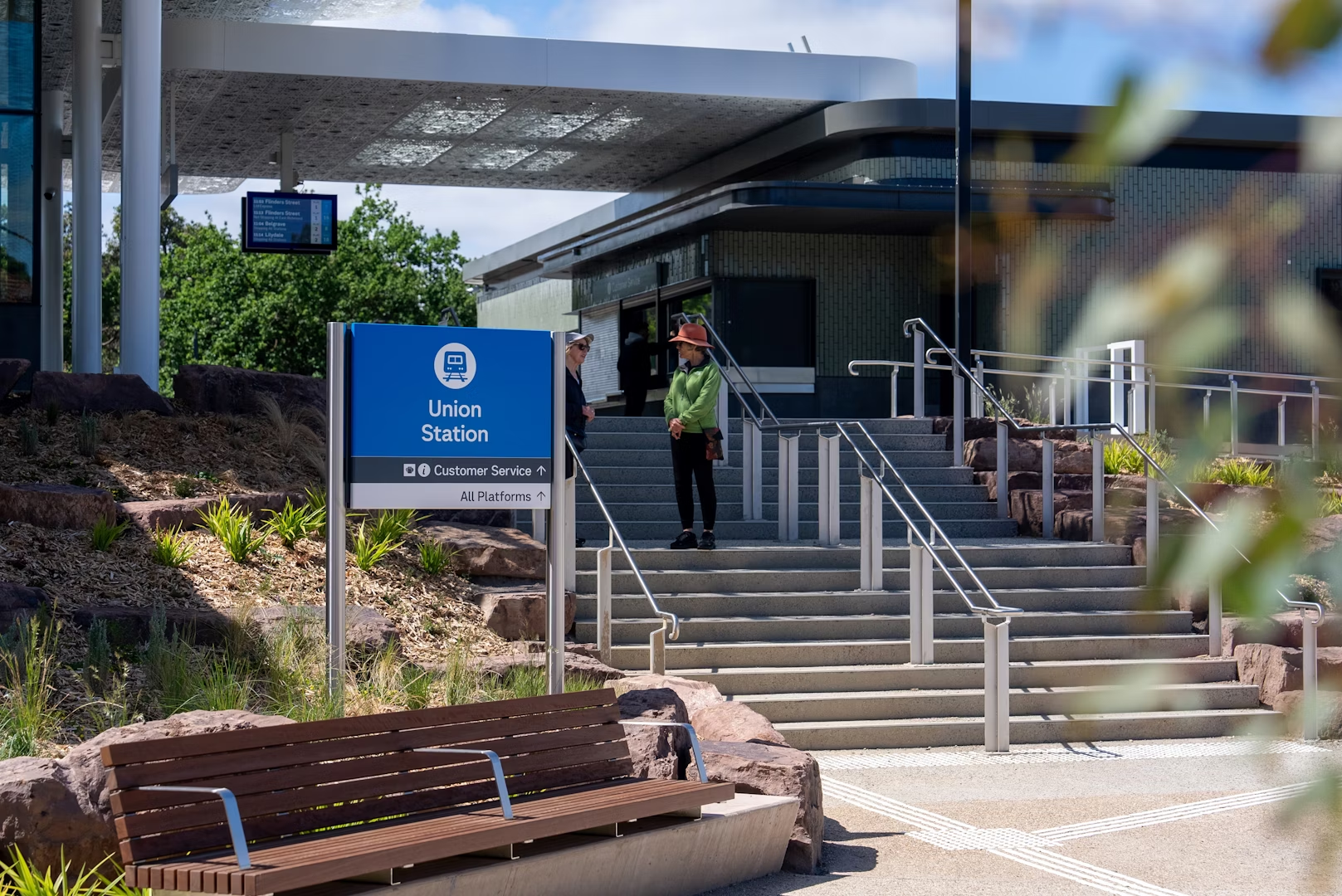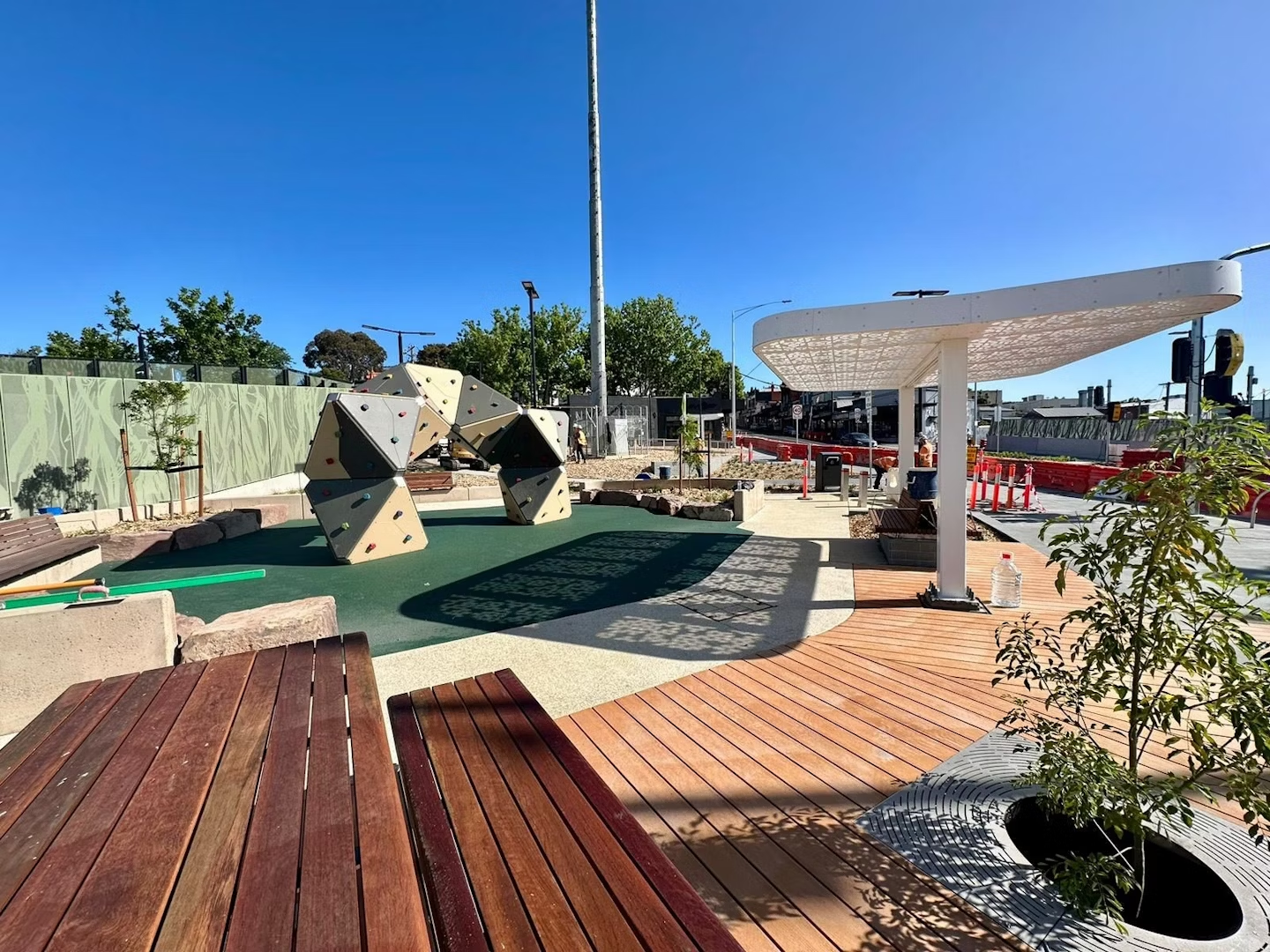Union Road & Mont Albert Road Level Crossing Removal Project – Environmental Outcomes
The Union Road and Mont Albert Road Level Crossing Removal Project has set a new standard in environmental sustainability through a build-less approach and the use of the decarbonisation hierarchy. By reducing construction scale, innovating material use, preserving heritage, and managing environmental discharges, the project has demonstrated a comprehensive approach to minimising environmental impact and achieving long-term sustainability.
The project achieved a reduction in embodied GHG emissions by 32%, driven by the avoidance of building an additional station and platforms. The project worked with the supply chain to pioneer the development of a 70% SCM pilling mix.
The team focused on preserving the history of the local area by refurbishing and repurposing the Mont Albert Station building as a community space. This reuse aligns with circular economy principles, yielding positive embodied carbon and community outcomes.
Describe WHAT you have done and HOW you have done it. Please provide a summary of your initiative, innovation, or approach.
The Union Road and Mont Albert Road Level Crossing Removal Project (UMA), delivered by the South Eastern Program Alliance (SEPA), implemented strong governance and leadership from the onset. There was also a focus on considerate decision making, adopting a build-less approach and innovative decarbonisation strategies.
The project focused on a standardised approach to gap analyses to allow for consistent approaches, and collective efforts to address areas for improvement. The project also embedded sustainability requirements and responsibilities into team strategies. The success of the project is a result of the early commitment and engagement of the whole team through shared sustainability responsibilities.
The award of the UMA project represented a new challenge for SEPA and an opportunity to leverage the power of the program to deliver an exemplar outcome. An Alliance-wide sustainability strategy was developed to align ambitious sustainability goals with the rest of the delivery strategy. The strategy focused on decarbonisation of scope 1, 2 and 3 emissions. The sustainability strategy considered the goals of each parent organisation to ensure alignment, all of whom have a focus on reducing greenhouse gas emissions and resource efficiency.
The project focused on decarbonisation by looking back at previous project data to understand where the scope 1 and scope 2 carbon sits within our typical level crossing removal projects – with approximately 20% of the construction phase emissions coming from site compound set up and the remaining 80% coming from fuel burn for plant and equipment on site. Of this, fuel represented approximately 90% of the total emissions. This data helped the team to set up frameworks to tackle both low-hanging fruit and the high-impact emissions.
A decarbonisation hierarchy was developed, with supplementary training and a site decarbonisation checklist disseminated to the wider team. The team also adopted a data driven approach to monitor, track, challenge, review, and improve based on data collected throughout the project. This allowed for certainty to meet the project’s decarbonisation goals and was presented on a dashboard available to all employees on the project.
Another pillar of the project’s sustainability strategy was Circular Economy. The top two elements of the circular economy hierarchy were championed on this project – avoidance and reuse. This occurred through knowledge sharing and upskilling the wider team on the design decisions that have the most impact on sustainable outcomes in the scope 3 space. Additionally, the project facilitated a major innovation with Victoria’s lowest-carbon piling mix.
There was a strong focus on promoting a culture of sustainability throughout the project, with interactive alliance-wide presentations on waste, online quizzes at wider team meetings, lunch and learns on topics that relate to the wider team, and regular toolbox talks to integrate the workforce. This helped to bring the wider staff and workforce on the journey and create buy-in.
What were the OUTCOMES and how were those outcomes shared?
The UMA project, has achieved significant environmental milestones by adopting a build-less approach and innovative decarbonisation strategies. This project sets a new benchmark in sustainability, focusing on reducing carbon emissions, preserving heritage, and managing environmental discharges effectively.
From the outset, the UMA project applied a build-less approach as part of its decarbonisation strategy. By consolidating the Surrey Hills and Mont Albert stations into a single facility, Union Station, the project embraced a top-tier principle in the decarbonisation hierarchy. This decision not only minimised the need for additional infrastructure but also substantially reduced material use and associated carbon emissions. The build-less approach demonstrates how strategic planning and design can lead to substantial long-term environmental benefits by focusing on reducing the scale of construction.
The UMA project achieved impressive environmental outcomes through several key measures. A reduction in embodied greenhouse gas emissions, the project realised a 32% reduction in embodied greenhouse gas emissions from materials, resulting in a 31% improvement in IS EnviroPoints. This reduction was driven by various factors. Optimised design included integrating two stations into one, the project avoided constructing an additional building, which contributed to a decrease in overall material use and emissions. The project achieved a lifecycle carbon reduction of 14,553 tonnes, or 61%, compared to the base case. This was accomplished through the installation of a 70kW solar array, an energy-efficient station design, and the use of an electric vehicle truck. The project diverted 40% of office waste from landfills by using recycled alternative waste streams, such as coffee cups and textiles, further reducing its environmental footprint.
The Alliance collaborated with the supply chain (Vinsi Partners, Keller, and Holcim) to co-develop to test and produce a 70% supplementary cementitious material (SCM) pilling mix by the Department of Transport. The introduction of the 70% SCM concrete mix was a major innovation, meeting environmental standards and demonstrating a scalable approach to reducing carbon emissions. This was further applied across SEPA projects including Bedford Road, Coolstore Road, and Dublin Road, and is projected to prevent around 4,000 tonnes of CO2 emissions compared to traditional methods. The approach’s benefits are through the power of the program expected to extend to other level crossing removal projects and change the benchmark in piling for the industry.
The project incorporated a 70 kW solar array and adopted energy-efficient design principles, reducing reliance on non-renewable energy sources and lowering overall carbon emissions. Additionally, the use of an electric truck contributed to a reduced carbon footprint in transportation and operational activities.
The UMA project made significant efforts to preserve and repurpose historic and heritage assets. The historic Mont Albert Station building was refurbished and repurposed as a community space within the new Mont Albert Plaza. This reuse aligns with the circular economy principle, yielding positive embodied carbon outcomes. The repurposing preserved local history and created a legacy with the use of contextually relevant materials, such as brick and bluestone, and heritage inspired furniture. The successful removal, storage, and reinstatement of a heritage palm tree further highlighted the project’s commitment to preserving cultural landmarks.
The project excelled in managing discharges related to noise, vibration, and light. High performance in the discharge credit category reflected effective governance and management practices. Despite a high volume of complaints, the team’s proactive communication and stakeholder relations strategies ensured that issues were resolved quickly and satisfactorily. The project achieved outstanding results in noise and vibration management, particularly in a densely populated area.
The upgraded UMA project has set a new standard in environmental sustainability through a build-less approach and the use of the decarbonisation hierarchy. By reducing construction scale, innovating in material use, preserving heritage, and effectively managing environmental discharges, the project has demonstrated a comprehensive approach to minimising environmental impact and achieving long-term sustainability.
Describe WHO benefited from your initiative, innovation, or approach?
Our environmentally sustainable approach has brought substantial benefits to multiple stakeholders, including the community, industry, and environment.
The primary beneficiaries of our initiatives are communities. By implementing a system for environmental credits linked to heritage conservation, we’ve enhanced the community’s access to funds that support local heritage projects. This approach promotes the preservation of cultural landmarks and fosters a sense of pride and engagement among residents. Additionally, the initiative has created job opportunities within the community, ranging from administrative roles to fieldwork positions, contributing to local economic growth. In terms of the environment, decarbonisation initiatives that focus on electrifying or renewables, such as the electric truck and the use of solar crib sheds, reduce noise and air pollution for the community.
Collaborating with supply chain partners Vinsi, Keller, and Holcim the project introduced a groundbreaking sustainable concrete mix, significantly advancing industry practices. By focusing on concrete and piling, key contributors to embodied carbon emissions, the team successfully increased the allowable proportion of SCM to 70%, an increase to double the previous limits. This change was approved by Victoria’s Department of Transport and Planning and has been implemented on major projects since, including SEPA’s Bedford Road, Coolstore Road, and Dublin Road. The team who worked on developing this mix focused on leading industry change by allowing Holcim, the concrete supplier, to own the mix, so that it is available for use on any project across Victoria. This is an exemplar showcase of genuine industry change. Its successful application on these projects demonstrates a scalable model for sustainability, with the potential for widespread impact as the level crossing removal projects expanded to 110 level crossings and Big Build projects continue in Victoria.
From an environmental perspective, our initiative has led to notable improvements. The integration of sustainable practices relating to discharge credits has reduced the environmental footprint associated with waste and emissions, including noise and vibration to the local community. The project had a strong collaborative approach between the Communications and Environment teams to ensure the community was aware of potential noise and vibration impacts early and offered respite and relocation to mitigate impacts.
By optimising resource use and promoting recycling and conservation efforts, we have significantly decreased the strain on natural resources. This has resulted in a cleaner environment and a reduction in social and environmental pollution, contributing to overall environmental sustainability and a more enjoyable environment for the community.
What LEGACY and UN SDG CONTRIBUTION was achieved?
A key achievement of the UMA project was the consolidation of the Surrey Hills and Mont Albert stations into the large Union station which services both communities. This ”build-less” approach marked a top-tier strategy in the decarbonisation hierarchy by minimising the need for additional infrastructure. By merging two stations into one, the project effectively reduced material usage and associated carbon emissions, showcasing how thoughtful design decisions can lead to substantial and enduring environmental benefits. This strategic decision also allowed for the creation of more community spaces.
By redesigning the stations, the project effectively reduced embodied greenhouse gas emissions by 32%, which translates to a 31% improvement in IS EnviroPoints. Notable reductions included a decrease in pile depth and a reduction in concrete and steel usage due to changes in design alignment. The project also trialed a pioneering 70% SCM concrete mix and employed PolyRok in pre-cast seating, which contributed to these savings.
In addition to the direct environmental benefits, the project secured a groundbreaking exemption from Victoria’s Department of Transport and Planning, allowing the use of up to 70% SCM in piling concretes. This exemption led to a 42% reduction in CO2 emissions compared to the previous benchmark, demonstrating a significant collaboration across the supply chain and advancement in sustainable construction practices. The new piling mix has successfully been implemented on other SEPA projects including Bedford Road, Coolstore Road, and Dublin Road, but also wider on other LXRP Alliances though the power of the program. The mix is planned to be used on other Big Build projects as well. This demonstrates the ripple effect and how the project is changing the industry’s traditional approach to piling.
The SEPA project’s legacy extends to its contributions to several UN Sustainable Development Goals.
SDG 9: Industry, Innovation, and Infrastructure - The project’s innovative approach to concrete sustainability and the successful regulatory challenge to increase SCM content in concrete mixes highlight advancements in building resilient infrastructure with reduced carbon footprints. By setting new industry standards and making sustainable practices more accessible, the project drives innovation in construction methods.
SDG 11: Sustainable Cities and Communities - Consolidating stations and repurposing the Mont Albert Station building as a community space aligned with the goal of creating sustainable urban environments. The reuse of historical elements and the creation of community areas contribute to enhanced livability and local heritage preservation.
SDG 12: Responsible Consumption and Production - The project demonstrated responsible resource management by utilising recycled materials and diverting 40% of office waste from landfills. This aligns with the principles of the circular economy and sustainable material use.
SDG 13: Climate Action - Achieving a 61% reduction in carbon emissions through energy-efficient designs, solar power, and the use of electric vehicles reflects a strong commitment to mitigating climate change. The project’s focus on reducing embodied carbon in concrete and its overall lifecycle carbon footprint further underscores its contribution to climate action.
SDG 15: Life on Land - The careful management of environmental impacts, including the removal and reinstatement of a heritage palm tree, demonstrates a commitment to preserving natural and cultural heritage. The project’s efforts to manage noise, vibration, and air quality also supports environmental sustainability.
The project’s innovative solutions and sustainability measures have set a new benchmark in the infrastructure industry. The achievements not only reduce environmental impacts but also enhance community spaces and uphold heritage, all while advancing several UN Sustainable Development Goals. The legacy of this project will influence future practices and contribute to more sustainable and resilient urban environments.



